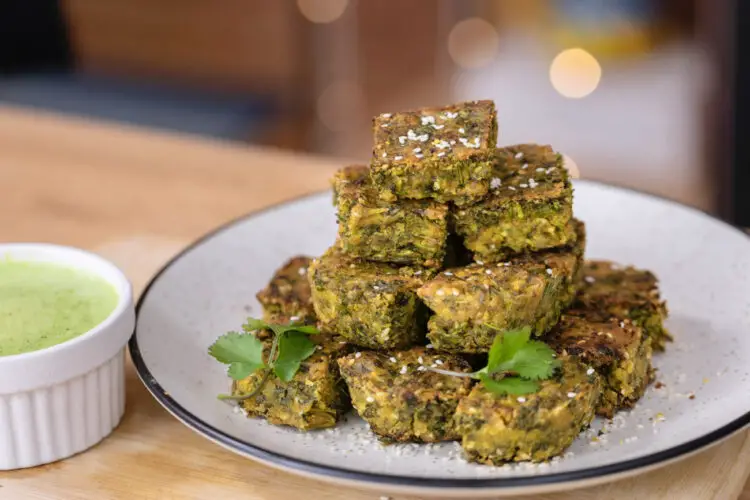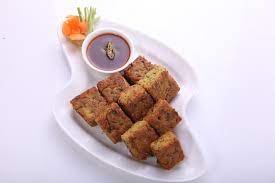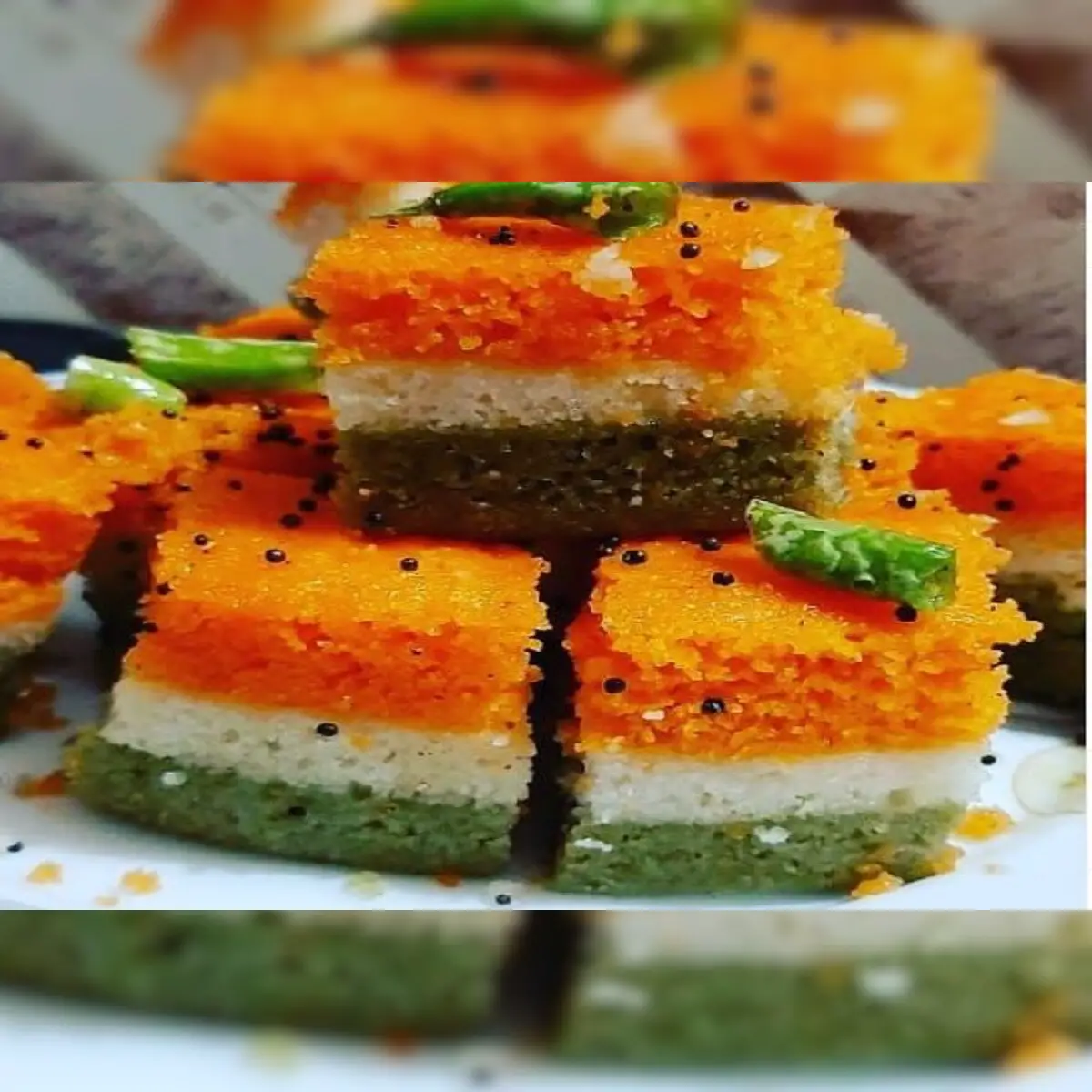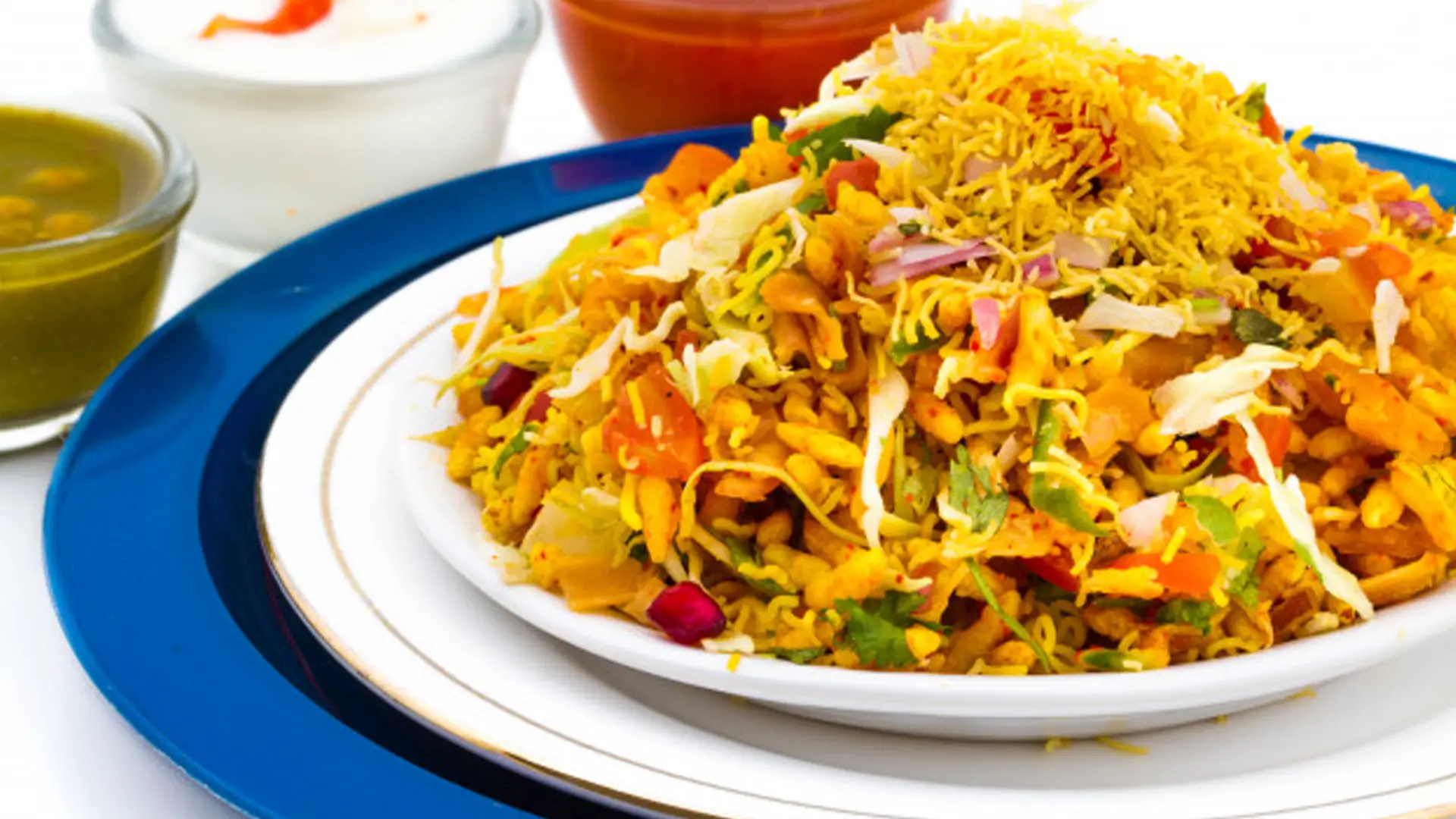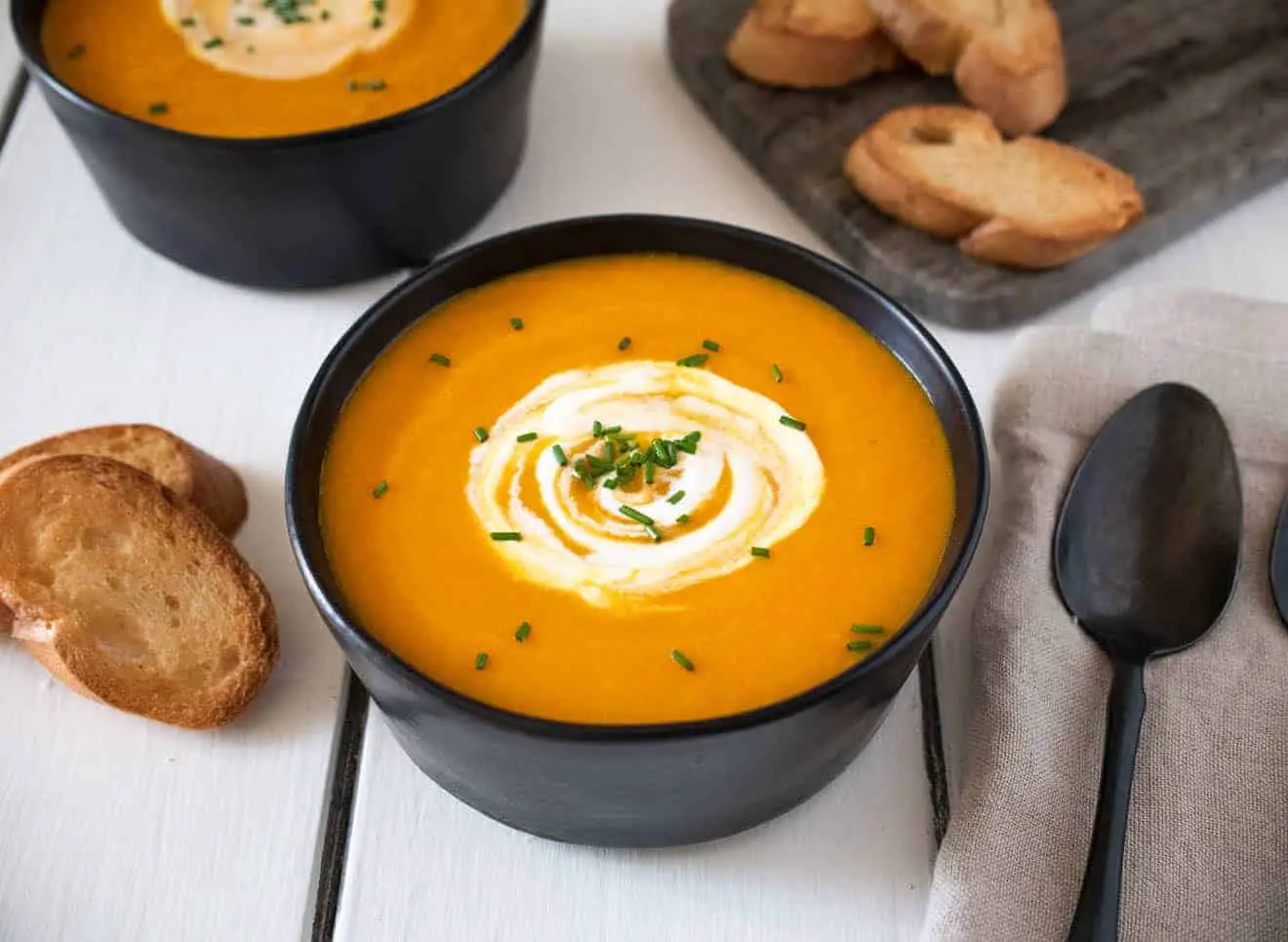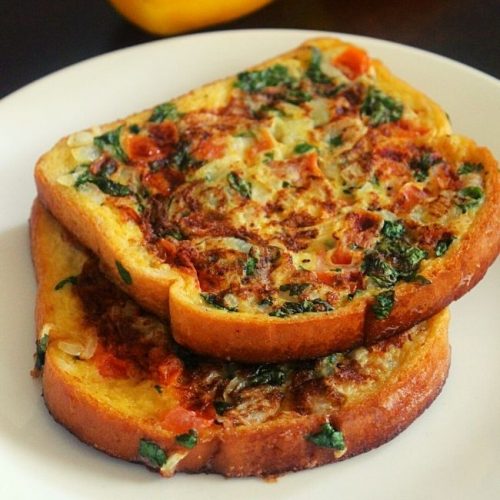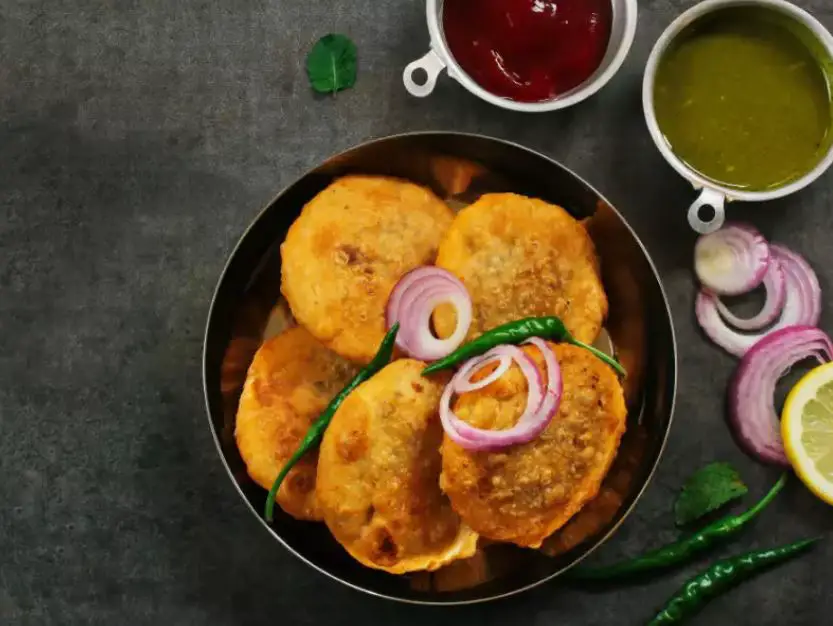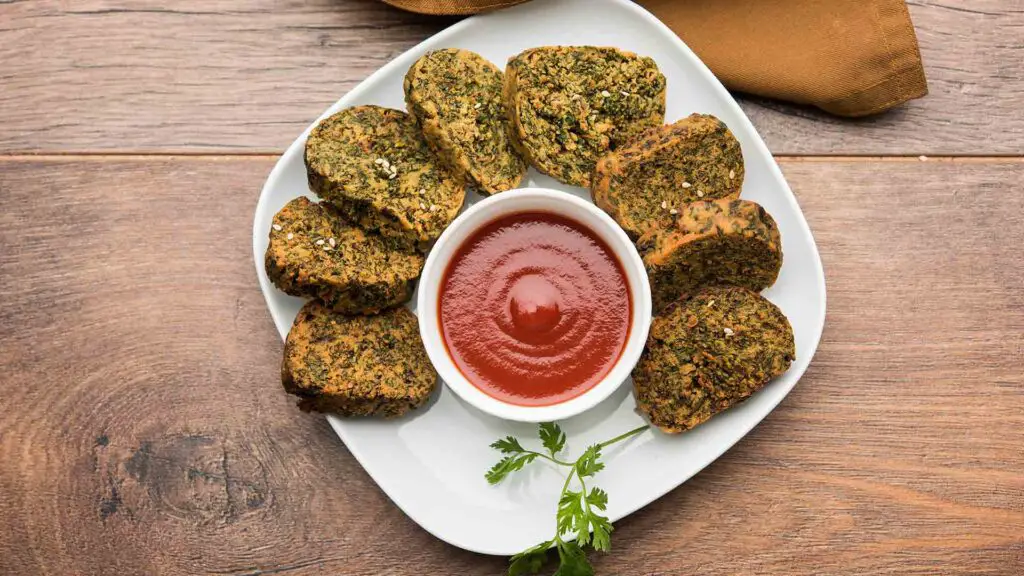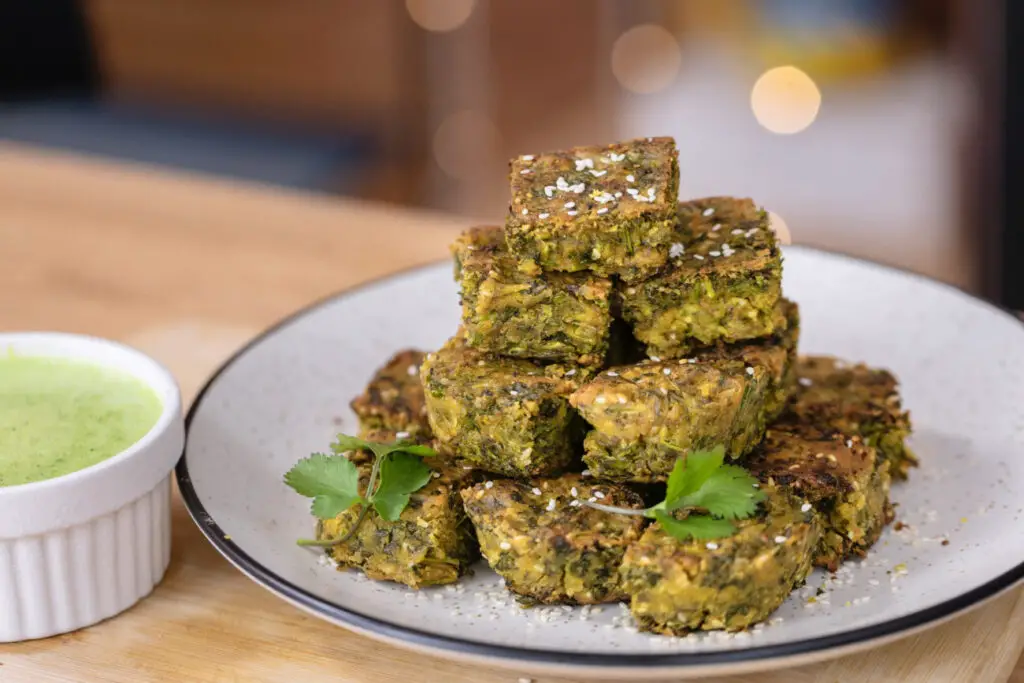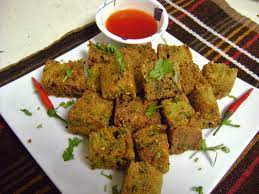About
Kothimbir Vadi is a beloved Maharashtrian snack that boasts a delightful blend of flavors and textures. This traditional dish captures the essence of Indian cuisine with its vibrant use of fresh coriander leaves (Kothimbir) and chickpea flour (besan). The process involves creating a flavorful batter, steaming it, and then frying until crispy.
The recipe starts by combining chickpea flour, rice flour, aromatic ginger, and garlic pastes, earthy turmeric powder, and a touch of red chili powder for a subtle kick. To this mixture, finely chopped fresh coriander leaves are added, imparting a verdant color and a distinctive herbaceous aroma. The batter is bound together with water, creating a thick and velvety mixture.
Aromatic spices are heated in oil to create a tantalizing tempering that infuses the dish with layers of flavor. This tempering is then combined with the coriander-chickpea flour mixture, resulting in a fragrant and aromatic base. The mixture is spread into a greased plate and steamed until it solidifies into a dense yet tender texture.
After steaming, the dish is cooled and artfully sliced into individual pieces. These pieces are shallow-fried until they undergo a magical transformation—crispy on the outside, while still retaining the essence of the vibrant coriander within.
The final creation, Kothimbir Vadi, is a symphony of taste and texture. With a satisfying crunch that gives way to a burst of coriander-infused flavors, it’s a delightful snack that encapsulates the rich culinary traditions of Maharashtra. Kothimbir Vadi can be savored as a teatime treat, a party appetizer, or even as a side dish, making it a versatile and cherished dish in Indian cuisine.
Kothimbir Vadi:
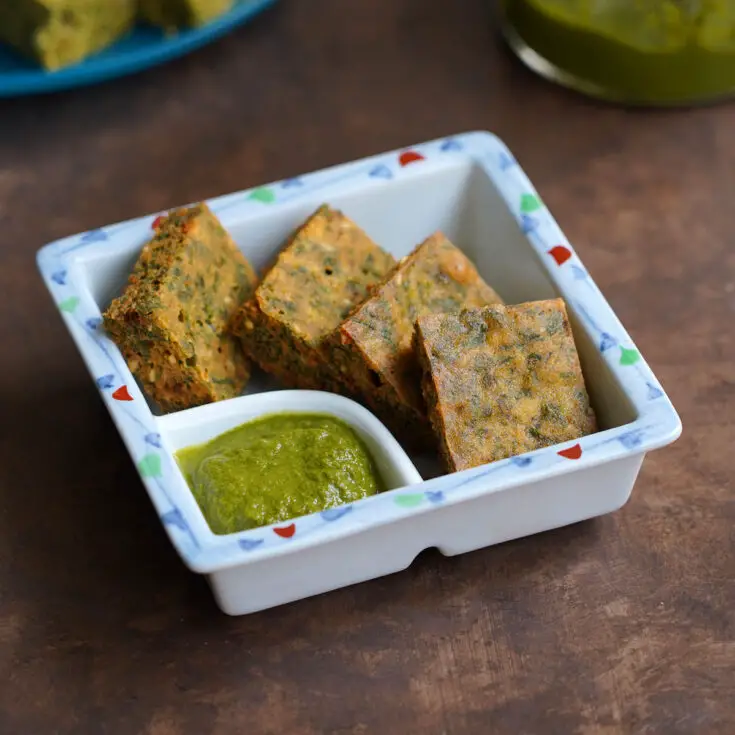
Kothimbir Vadi is a popular Maharashtrian snack made from fresh coriander leaves (Kothimbir) and chickpea flour (besan). It's a savory dish that's both flavorful and crispy.
Ingredients
- 3 cups chopped fresh coriander leaves
- 1.5 cups chickpea flour (besan)
- 1/4 cup rice flour
- 2 teaspoons ginger paste
- 2 teaspoons garlic paste
- 1 teaspoon turmeric powder
- 2 teaspoons red chili powder (adjust to taste)
- 2 teaspoons cumin seeds
- Salt to taste
- Water, as needed
- 3 tablespoons oil
- 2 teaspoons mustard seeds
- 2 teaspoons sesame seeds
- A pinch of asafoetida (hing)
- Curry leaves
- Oil for shallow frying
Instructions
- In a mixing bowl, combine the chickpea flour, rice flour, yogurt, ginger paste, garlic paste, turmeric powder, red chili powder, cumin seeds, and salt. Mix well.
- Add the chopped coriander leaves to the mixture and combine until the leaves are well coated with the batter.
- Gradually add water and mix to form a thick batter. The batter should be smooth and lump-free.
- Grease a plate or a shallow dish with oil to set the vadis. Set it aside.
- Heat 2 tablespoons of oil in a pan. Add mustard seeds and let them splutter. Then add sesame seeds, asafoetida, and curry leaves. Sauté for a few seconds.
- Pour the tempering over the coriander-chickpea flour mixture and mix well.
- Transfer the mixture to a steamer or a microwave-safe dish. Steam it for about 15-20 minutes until it's cooked and firm. You can also test the doneness by inserting a knife or toothpick; it should come out clean.
- Allow the steamed mixture to cool down a bit. Then, using a knife, cut it into square or diamond-shaped pieces.
- Heat oil in a pan for shallow frying. Carefully place the cut pieces in the hot oil and fry them until they turn golden brown and crispy on both sides.
- Once fried, remove the vadis from the oil and place them on paper towels to absorb excess oil.
- Serve the Kothimbir Vadi hot with green chutney or tamarind chutney.
- Enjoy your delicious and crispy Kothimbir Vadi as a snack or appetizer!
Notes
Recommended Products
As an Amazon Associate and member of other affiliate programs, I earn from qualifying purchases.
Nutrition Information:
Serving Size:
1 piece, about 30 gramsAmount Per Serving: Calories: 80-100Total Fat: 4-5gCarbohydrates: 10-12gFiber: 1-2gProtein: 2-3g
Serving Suggestions
- Serve Kothimbir Vadi with a variety of chutneys for dipping. Green chutney (coriander and mint chutney) and tamarind chutney are classic choices. Their tangy and spicy flavors complement the savory Vadis perfectly.
- Pair the crispy vadis with plain yogurt or a yogurt-based dip. This provides a cooling contrast to the spices and adds a creamy element to your snack.
- Enjoy Kothimbir Vadi as a teatime snack along with a hot cup of chai or coffee. Its savory flavors make it an ideal companion to your afternoon beverage.
- Serve Kothimbir Vadi as an appetizer at parties, gatherings, or formal dinners. The vibrant color and distinct taste will surely be a hit among your guests.
- In some Maharashtrian households, Kothimbir Vadi is served as a side dish with main meals. It can be a tasty addition to your thali (traditional Indian meal platter).
- Create a street food experience by serving Kothimbir Vadi with finely chopped onions, tomatoes, and a sprinkle of chaat masala on top. This adds extra crunch and flavor to the dish.
- Crumble the Vadis and use them as a topping for salads. They can add a delightful crunch and a burst of flavor to your greens.
- Use Kothimbir Vadi as a filling for wraps or rolls. Place pieces of vadis in a tortilla or flatbread along with some greens and chutney, and roll it up for a quick and satisfying meal.
- Pack Kothimbir Vadi in lunchboxes for school or work. They stay crispy for a reasonable amount of time and make for a tasty and fulfilling snack.
- Experiment with different presentations, such as arranging them on a platter with a garnish of fresh coriander leaves or using them as an ingredient in fusion dishes.
Frequently Asked Questions (FAQs)
Q: What is Kothimbir Vadi?
A: Kothimbir Vadi is a traditional Maharashtrian snack made from fresh coriander leaves (Kothimbir) and chickpea flour (besan). The mixture is spiced, steamed, cut into pieces, and then shallow-fried until crispy.
Q: Is Kothimbir Vadi gluten-free?
A: The traditional recipe uses chickpea flour (besan), which is gluten-free. However, some variations might include other flours like wheat or rice flour. To make it gluten-free, ensure you’re using gluten-free besan and avoid adding flour with gluten.
Q: Can I make Kothimbir Vadi without yogurt?
A: Yes, you can make Kothimbir Vadi without yogurt. Yogurt adds a slight tang and helps tenderize the mixture, but you can replace it with water or a non-dairy yogurt alternative.
Q: Can I bake Kothimbir Vadi instead of frying it?
A: While traditionally Kothimbir Vadi is shallow-fried, you can experiment with baking them for a healthier option. Preheat your oven, place the vadis on a greased baking tray, and bake them at around 350°F (175°C) until they turn golden and crisp.
Q: How do I store leftover Kothimbir Vadi?
A: Allow the Vadis to cool completely, then store them in an airtight container. They can be refrigerated for a few days. To reheat, you can use an oven, microwave, or stovetop skillet to restore their crispiness.
Q: Can I freeze Kothimbir Vadi?
A: Freezing Kothimbir Vadi is possible, but the texture might change slightly after thawing. If you plan to freeze them, it’s best to freeze them after steaming but before frying. Thaw them in the refrigerator before frying or reheating.
Q: What can I add to customize the flavor of Kothimbir Vadi?
A: You can add grated coconut, finely chopped onions, crushed peanuts, or even sesame seeds to the batter for additional flavor and texture variations.
Q: Is Kothimbir Vadi spicy?
A: The spiciness level of Kothimbir Vadi depends on the amount of red chili powder you use. You can adjust the spice according to your preference.
Q: Is Kothimbir Vadi vegan?
A: The traditional recipe includes yogurt, which is not vegan. However, you can use non-dairy yogurt or omit the yogurt altogether to make the recipe vegan-friendly.
Q: Can I use dried coriander leaves instead of fresh ones?
A: Fresh coriander leaves provide a distinct flavor and color to Kothimbir Vadi. Dried coriander leaves won’t yield the same results. It’s best to use fresh coriander leaves for this recipe.
Conclusion
In conclusion, Kothimbir Vadi is a delectable Maharashtrian snack that embodies the essence of Indian culinary craftsmanship. With its blend of fresh coriander leaves and chickpea flour, it encapsulates the rich flavors, aromas, and textures that define traditional Maharashtrian cuisine.
The journey to create this dish involves crafting a flavorful batter infused with ginger, garlic, and a medley of spices. The addition of vibrant coriander leaves lends a visual appeal and a distinct herbal fragrance, while the interplay of textures between the tender interior and crispy exterior creates a delightful contrast.
Through the artful process of tempering, steaming, and frying, Kothimbir Vadi emerges as a harmonious symphony of taste and presentation. It beckons as a versatile snack, whether enjoyed during teatime, as a party favorite, or even as a side dish to elevate a meal.
With every bite, Kothimbir Vadi embodies the legacy of time-honored culinary traditions, a representation of the care and attention that goes into crafting a dish that delights the senses and brings people together. Its unique blend of flavors, textures, and aromas reflects the cultural richness of Maharashtra and showcases the intricate balance that defines Indian gastronomy.
So, as you savor the crispy and flavorful bites of Kothimbir Vadi, you not only experience the essence of this traditional Maharashtrian delicacy but also connect with the heart of Indian culinary heritage—a journey of taste and tradition that transcends time and borders.
follow us on instagram, facebook and youtube

